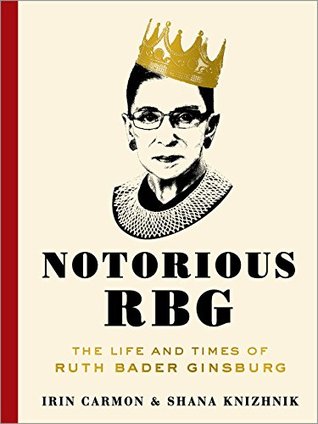
by fljustice | Mar 9, 2018 | Biographies, Books, Reviews, Wonderful Women
Notorious RBG: The Life and Times of Ruth Bader Ginsburg
by Irin Carmon and Shana Knizhnik
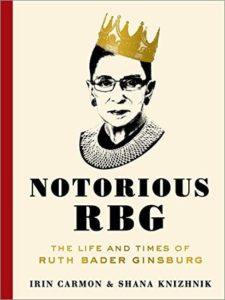 It’s Women’s History Month so here is another entry in books by and/or about women. I’ve been a fan of Ruth Bader Ginsburg since my earliest feminist days. The second woman to join the Supreme Court (appointed by Bill Clinton in 1993), she served for twenty-seven years as a liberal voice, sometimes shouting into the wilderness; other times changing minds. As the sole women in a tenured position in the Columbia Law School, she co-founded the Woman’s Rights Project at the ACLU in 1971. RGB shepherded some of the most ground-breaking sex discrimination suits through the courts, arguing six cases before the Supreme Court. She won five. She carefully built a foundation of decisions that led to an inevitable conclusion. Discrimination based on gender was unconstitutional. Her death in 2020 left a huge hole in the Supreme Court. Her replacement consolidated the conservative super-majority of six justices that resulted in the avalanche of opinions that have rolled back many of RBG’s most cherished accomplishments. (more…)
It’s Women’s History Month so here is another entry in books by and/or about women. I’ve been a fan of Ruth Bader Ginsburg since my earliest feminist days. The second woman to join the Supreme Court (appointed by Bill Clinton in 1993), she served for twenty-seven years as a liberal voice, sometimes shouting into the wilderness; other times changing minds. As the sole women in a tenured position in the Columbia Law School, she co-founded the Woman’s Rights Project at the ACLU in 1971. RGB shepherded some of the most ground-breaking sex discrimination suits through the courts, arguing six cases before the Supreme Court. She won five. She carefully built a foundation of decisions that led to an inevitable conclusion. Discrimination based on gender was unconstitutional. Her death in 2020 left a huge hole in the Supreme Court. Her replacement consolidated the conservative super-majority of six justices that resulted in the avalanche of opinions that have rolled back many of RBG’s most cherished accomplishments. (more…)
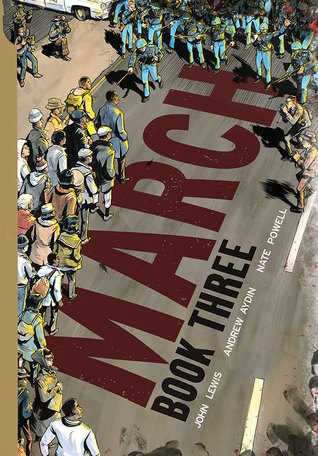
by fljustice | Feb 26, 2018 | Biographies, Books, History, Reviews
March: Book Three
by John Lewis, Andrew Aydin (co-authors), Nate Powell (Illustrator)
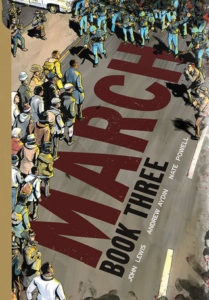 I finished the third volume in civil rights icon John Lewis’ graphic memoir about his early days in the movement leading up to the march from Selma to Montgomery, Alabama. (If you missed it my review of the first two books is here.) March: Book Three is the longest of the trilogy and covers the shortest amount of time. It opens in September 1963 with the bombing of the Sixteenth Street Baptist Church in Birmingham which killed four young girls. Everyone remembers the horror of that act of terrorism, but I didn’t know this was the church’s annual “Youth Day” and 24 other children were injured. The terrorists deliberately targeted African American children in their church. Shortly after that, a group of Eagle Scouts, who had just attended a clan rally, shot a 13-year-old black boy from his bicycle and killed him; and a police officer shot and killed a 16-year-old black youth who chucked a rock at a car full of teens who were celebrating the deaths of the girls. The book continues through to March 7, 1965, Bloody Sunday in Selma which included the beating death of Unitarian minister James Reeb, the later peaceful march to Montgomery, and the assassination of Viola Liuzzo, a 39-year-old mother from Detroit who was shuttling volunteers from Birmingham back to Selma. Four months later on August 6, President Johnson signed the 1965 Voting Rights Act into law. (more…)
I finished the third volume in civil rights icon John Lewis’ graphic memoir about his early days in the movement leading up to the march from Selma to Montgomery, Alabama. (If you missed it my review of the first two books is here.) March: Book Three is the longest of the trilogy and covers the shortest amount of time. It opens in September 1963 with the bombing of the Sixteenth Street Baptist Church in Birmingham which killed four young girls. Everyone remembers the horror of that act of terrorism, but I didn’t know this was the church’s annual “Youth Day” and 24 other children were injured. The terrorists deliberately targeted African American children in their church. Shortly after that, a group of Eagle Scouts, who had just attended a clan rally, shot a 13-year-old black boy from his bicycle and killed him; and a police officer shot and killed a 16-year-old black youth who chucked a rock at a car full of teens who were celebrating the deaths of the girls. The book continues through to March 7, 1965, Bloody Sunday in Selma which included the beating death of Unitarian minister James Reeb, the later peaceful march to Montgomery, and the assassination of Viola Liuzzo, a 39-year-old mother from Detroit who was shuttling volunteers from Birmingham back to Selma. Four months later on August 6, President Johnson signed the 1965 Voting Rights Act into law. (more…)
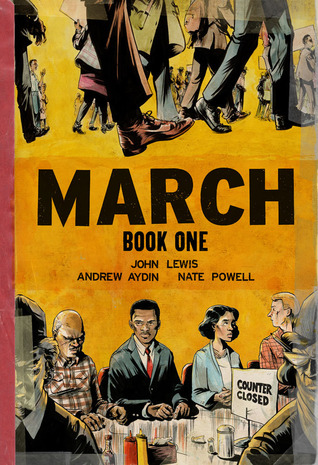
by fljustice | Feb 19, 2018 | Biographies, Books, History, Reviews
March: Book One and March: Book Two
by John Lewis, Andrew Aydin (Co-authors), Nate Powell (Artist)
Blurb:
March is a vivid first-hand account of John Lewis’ lifelong struggle for civil and human rights, meditating in the modern age on the distance traveled since the days of Jim Crow and segregation. Rooted in Lewis’ personal story, it also reflects on the highs and lows of the broader civil rights movement.
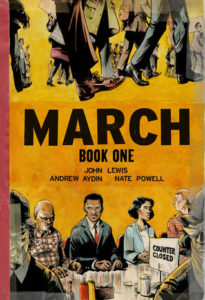 Continuing with my Black History Month project, I finished Representative John Lewis’ trilogy of graphic books: March. These three books are a remarkable achievement and recommended for adults and children alike. Lewis, a true American treasure and Civil Rights icon, wrote a couple of traditional memoirs based on his role in the Civil Rights struggles. This graphic project was inspired by an early “comic” about Dr. Martin Luther King that circulated during those turbulent times and inspired many young people to join the fight. The lead up to, and march for, voting rights in Selma, Alabama is laid out in touching detail.
Continuing with my Black History Month project, I finished Representative John Lewis’ trilogy of graphic books: March. These three books are a remarkable achievement and recommended for adults and children alike. Lewis, a true American treasure and Civil Rights icon, wrote a couple of traditional memoirs based on his role in the Civil Rights struggles. This graphic project was inspired by an early “comic” about Dr. Martin Luther King that circulated during those turbulent times and inspired many young people to join the fight. The lead up to, and march for, voting rights in Selma, Alabama is laid out in touching detail.
Book One is the shortest of the three but covers the most time of the trilogy. It deals with Lewis’ early years, his struggle (even against his parents) to get an education and his growing sense of injustice in the segregated south. John Lewis struggled and “pulled himself up by his bootstraps” against enormous odds. This book lays the foundation for everything that is to come, everything that shaped his personality and made him the formidable man he was to become. It concludes with the successful integration of Nashville, Tennessee’s downtown drug store counters. We get a behind the scenes look at the politics and strategies employed by a dedicated group of young people working to make their world more fair: the first steps in the Civil Rights movement. I particularly liked the framing story–the morning of President Obama’s first inauguration–which gave the narrative poignancy. (more…)

by fljustice | Feb 12, 2018 | Biographies, Books, History, Reviews
Book Review: Narrative of the Life of Frederick Douglass, an American Slave and Other Writings
Blurb:
“This dramatic autobiography of the early life of an American slave was first published in 1845, when its young author had just achieved his freedom. Douglass’ eloquence gives a clear indication of the powerful principles that led him to become the first great African-American leader in the United States.”
Welcome to Black History Month!
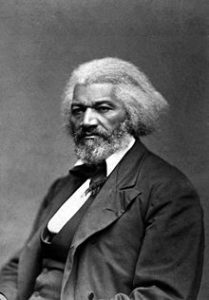
Frederick Douglass c 1874
I always look forward to February and March because it puts the spotlight on two marginalized groups in history. As a history geek, I would prefer that we didn’t need those spotlights, but given the current political backlash against all “others,” I don’t think we’ll be reaching that point soon. So one of my contributions this year is a review of the venerable autobiography of Frederick Douglass, an escaped american slave, abolitionist, preacher and revered leader of the African American community. As a scholar of ancient history, I value primary sources (which are few in my chosen time of 5C Rome). This autobiography is a precious record of a troubling period in our American History from a man who experienced it first hand. This is a classic of American literature and a rebuke to all folks who insist that the Civil War was fought over “heritage.” (more…)

by fljustice | Apr 2, 2015 | Biographies, Books, History, Reviews, Wonderful Women
Boudica, Queen of the Iceni:
Two books
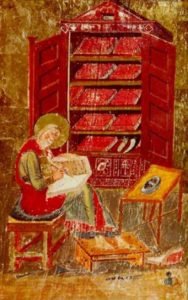 We authors—especially of historical fiction—cannot get along without our research books. (We also like to visit the places we write about, explore museum exhibits, and participate in archaeology and reenactments, but this post will talk about research of the armchair variety.) We prefer primary sources: journals, diaries, letters, histories, account lists, and literature written in the period, describing the people and events we want to write about; but that’s not always possible. For cultures that didn’t have a written language (the Iron Age Celts), or it was indecipherable (Egyptian hieroglyphs until the discovery of the Rosetta stone), or it was destroyed (Mayan books burned by conquering Spaniards); we have to rely on secondary sources. Books, essays, and articles by academics and other professionals in their fields are the best we can do for written research in such cases. But we have to be careful even with those. Just as in evaluating primary sources we have to keep in mind the biases and knowledge of the writer, we have to do the same with secondary sources. Let’s face it, there’s a lot of dreck out there—particularly on the internet—and historical fiction authors usually like to get as close to the truth as possible.
We authors—especially of historical fiction—cannot get along without our research books. (We also like to visit the places we write about, explore museum exhibits, and participate in archaeology and reenactments, but this post will talk about research of the armchair variety.) We prefer primary sources: journals, diaries, letters, histories, account lists, and literature written in the period, describing the people and events we want to write about; but that’s not always possible. For cultures that didn’t have a written language (the Iron Age Celts), or it was indecipherable (Egyptian hieroglyphs until the discovery of the Rosetta stone), or it was destroyed (Mayan books burned by conquering Spaniards); we have to rely on secondary sources. Books, essays, and articles by academics and other professionals in their fields are the best we can do for written research in such cases. But we have to be careful even with those. Just as in evaluating primary sources we have to keep in mind the biases and knowledge of the writer, we have to do the same with secondary sources. Let’s face it, there’s a lot of dreck out there—particularly on the internet—and historical fiction authors usually like to get as close to the truth as possible.
In researching Sword of the Gladiatix, I collected several books, articles, and pamphlets on Boudica and Roman Britain, most of an academic nature, a few of the more “popular” variety. The two biographies of Boudica I review below are the best by far of both types. You can read either or both and get a well-researched, readable history of the Iceni Queen, her times, and her legacy in popular culture. Which to read depends on your needs and nature. (more…)
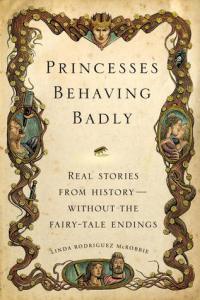
by fljustice | Nov 22, 2013 | Biographies, Books, History, Reviews, Wonderful Women
Princesses Behaving Badly: Real Stories from History without the Fairy-Tale Endings
by Linda Rodriquez McRobbie
“Once upon a time, there lived a beautiful princess who wasn’t afraid to cheat, deceive, seduce or murder anyone who got in her way.”
 I like these kinds of books—collections of short bios of (mostly) unknown women who are remarkable for doing daring/unusual things down through history. I have one on women at sea; several on women warriors; others on women explorers, mathematicians, and scientists. They generally follow a pattern of one to two page biographies written in a breezy, modern style emphasizing the outrageousness (for her time) of the woman’s actions.
I like these kinds of books—collections of short bios of (mostly) unknown women who are remarkable for doing daring/unusual things down through history. I have one on women at sea; several on women warriors; others on women explorers, mathematicians, and scientists. They generally follow a pattern of one to two page biographies written in a breezy, modern style emphasizing the outrageousness (for her time) of the woman’s actions.
Why do I like these kinds of books? To be honest, they’re snack food—light fluffy reads that give me a break from heavy turgid research books. They also remind me that—despite what the history books tell us—some women in every era, somewhere in the world, were doing remarkable things. The majority (like today) lived ordinary lives, but a few women always stood out and lived extraordinary ones. I like learning about them and being inspired to tell their stories. This kind of book is a good starting point for any historical novelist looking for inspiration.
(more…)

 It’s Women’s History Month so here is another entry in books by and/or about women. I’ve been a fan of Ruth Bader Ginsburg since my earliest feminist days. The second woman to join the Supreme Court (appointed by Bill Clinton in 1993), she served for twenty-seven years as a liberal voice, sometimes shouting into the wilderness; other times changing minds. As the sole women in a tenured position in the Columbia Law School, she co-founded the Woman’s Rights Project at the ACLU in 1971. RGB shepherded some of the most ground-breaking sex discrimination suits through the courts, arguing six cases before the Supreme Court. She won five. She carefully built a foundation of decisions that led to an inevitable conclusion. Discrimination based on gender was unconstitutional. Her death in 2020 left a huge hole in the Supreme Court. Her replacement consolidated the conservative super-majority of six justices that resulted in the avalanche of opinions that have rolled back many of RBG’s most cherished accomplishments. (more…)
It’s Women’s History Month so here is another entry in books by and/or about women. I’ve been a fan of Ruth Bader Ginsburg since my earliest feminist days. The second woman to join the Supreme Court (appointed by Bill Clinton in 1993), she served for twenty-seven years as a liberal voice, sometimes shouting into the wilderness; other times changing minds. As the sole women in a tenured position in the Columbia Law School, she co-founded the Woman’s Rights Project at the ACLU in 1971. RGB shepherded some of the most ground-breaking sex discrimination suits through the courts, arguing six cases before the Supreme Court. She won five. She carefully built a foundation of decisions that led to an inevitable conclusion. Discrimination based on gender was unconstitutional. Her death in 2020 left a huge hole in the Supreme Court. Her replacement consolidated the conservative super-majority of six justices that resulted in the avalanche of opinions that have rolled back many of RBG’s most cherished accomplishments. (more…)







